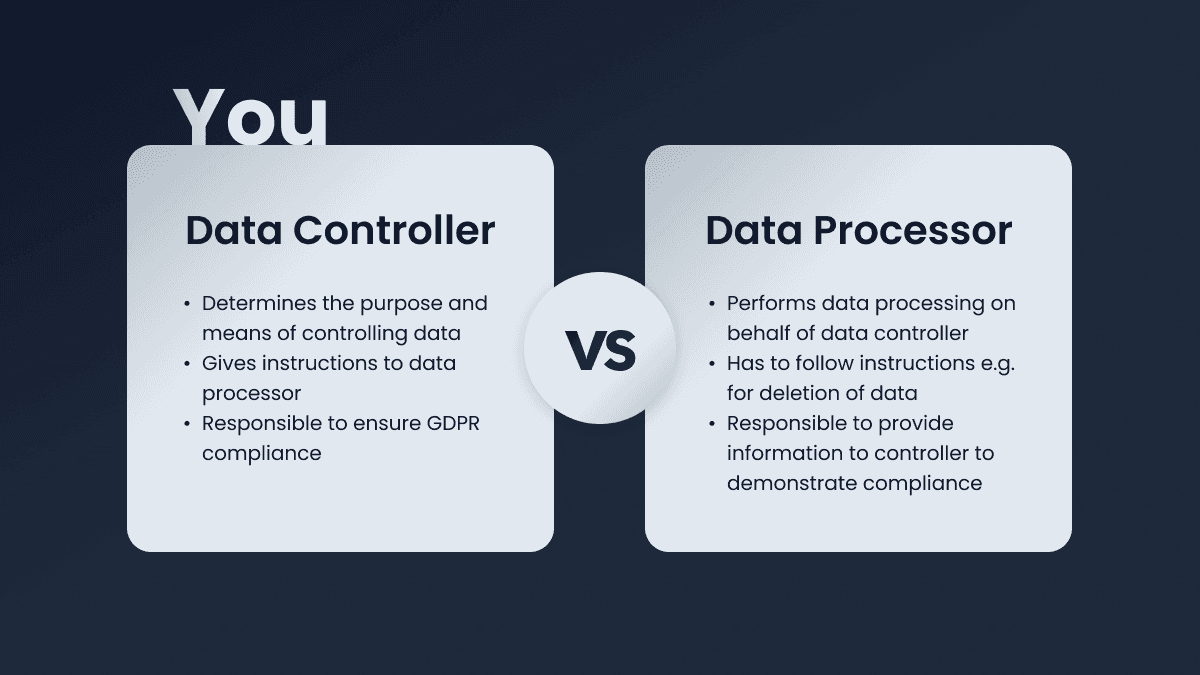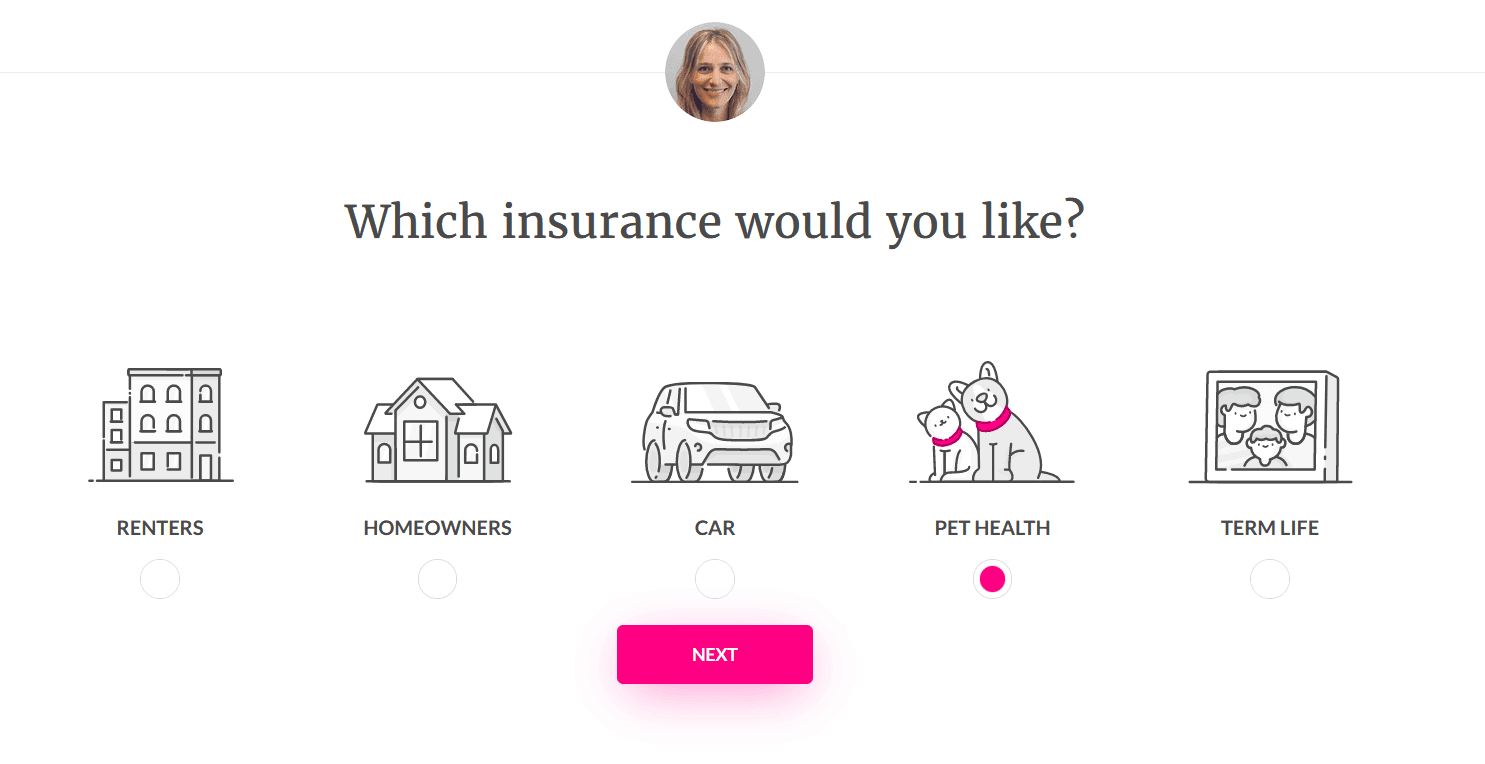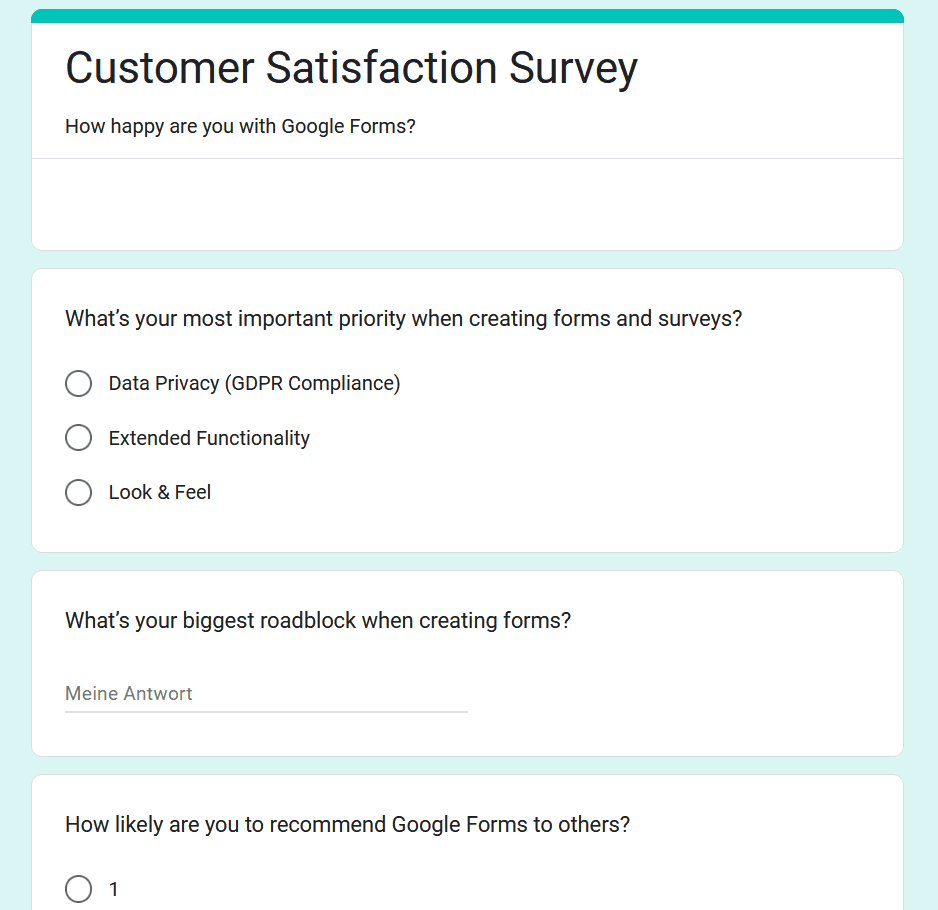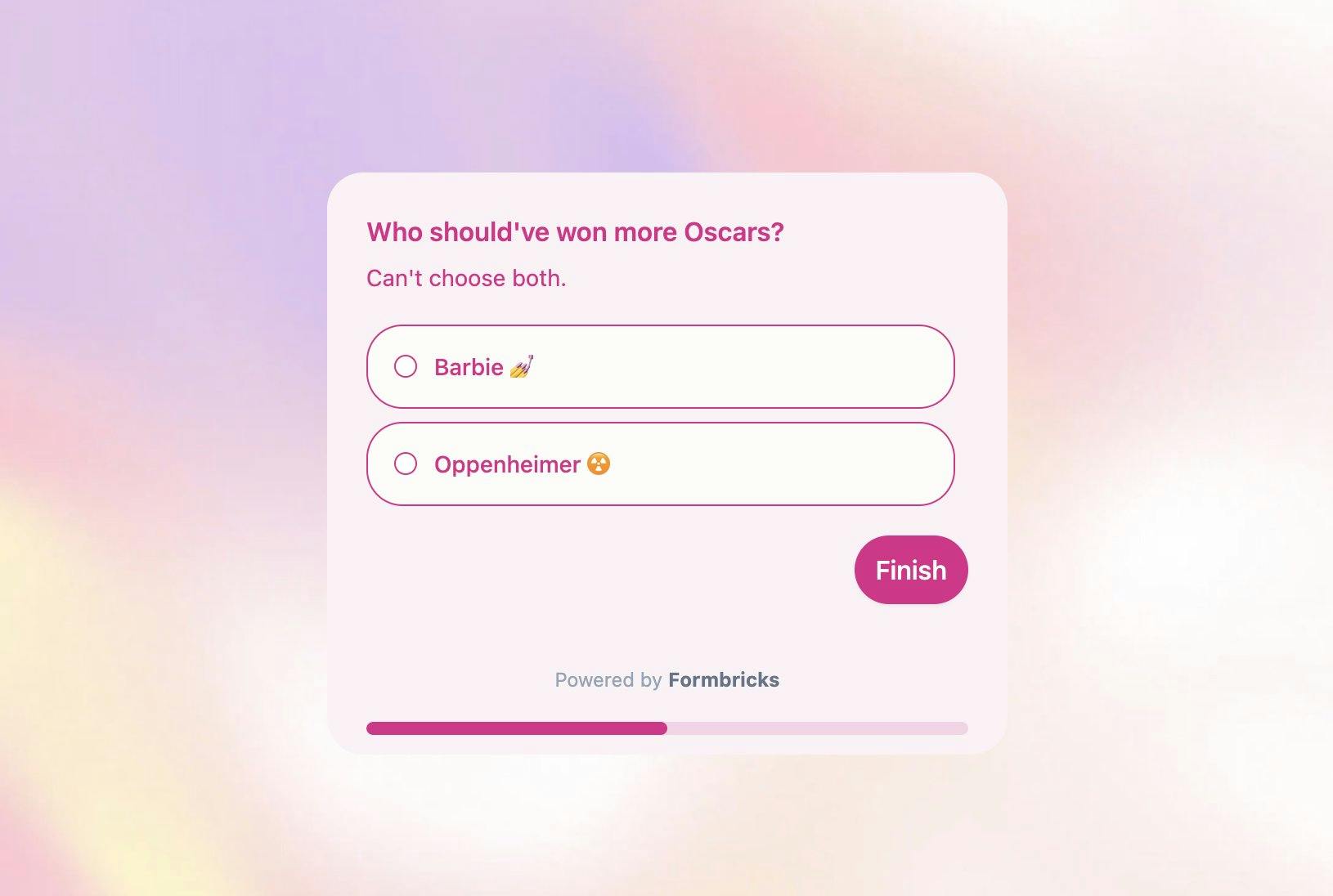Google Forms Open Source Alternative
Google Forms is among the most used form and survey solutions out there. However, the lack of data privacy and old-fashioned look and feel have people looking for open source Google Forms alternatives.

When you’re looking for an open source Google Forms alternative, you usually have one of the following problems with it:
- Google Forms is not really GDPR compliant so you need an alternative when you are an institution based in the EU or process data from EU citizens
- Google Forms looks and feels old and you’d like an alternative which looks more like Typeform
How will we compare Google Forms vs Formbricks?
To give you a full picture of how Google Forms and Formbricks compare, we will look at these three aspects:
- Data Privacy
- Features & Functionality
- Look & Feel
Let's dive in!

Data Privacy
No legal advice
None of the information here is legal advice. Please consult with an expert before making your decision.
Can I use Google Forms compliant with GDPR?
The short answer is: With a lot of additional work you might but there is still legal risk attached to it.
Here are all the measure you have to take to use Google forms when you are based in the EU or there is the possibility that EU citizens fill in one of your Google Forms:
- Before the Google Form is loaded on your page you need to collect and document consent from the visitors. Google always sets non-essential cookies and according to the European Court of Justice (Az. C-673/17) this requires consent. And,
- Sign a Data Processing Agreement (DPA) with Google because you are forwarding personal data to Google. This DPA has to include what user data Google stores, how long it stores this data, why it stores the data and what rights and obligations companies and Google have.
- Update your Privacy Policy to inform your respondents why you collect personal data via Google Forms, how long you want to store the data, which legal basis allows you to do so and that you have concluded an DPA agreement with Google for the data transfer
- Check standard contractual clauses. This is the tricky part because the European Court of Justice decided in July 2020 that the Privacy Shield is not active anymore. In simple terms, the Privacy Shield assured that data transfers between the EU and USA are legal. Without the Privacy Shiel it is your responsibility to prove that. This includes information about when you asked Google about the new standard contractual clauses, what the review of the standard contractual clauses revealed, why the review of the standard contractual clauses turned out the way it did, what type of data is involved (e.g. particularly sensitive data such as health data), which legal provisions apply in the third country - in this case the USA - and whether your respondents can use additional protection measures, such as SSL encryption.
Good luck 😊

Why open-source self-hosted solutions are GDPR compliant
Now, this obviously is a lot to take in. The good news is that you don’t need any of it with a self-hosted solution 🎉 Why not? Because self-hosting an open source Google Forms alternative like Formbricks ensures full control over your data.
It is a lot easier to comply with GDPR when you don’t forward your data to a different company or jurisdiction. If you hold your data on your own servers, all you have to do is:
- Inform your respondents that you store their data and for how long
- Allow them to request what data you have stored about them (an email address is enough)
- And delete the data when they ask you to (e.g. also via email)
You can cover all of this in a few sentences in your Privacy Policy.
You are the data controller
In all cases, when you create and share around a survey, you are the data controller. The form and survey provider is only the data processor. This means that you are responsible to comply with the GDPR framework.
Why open-source EU-hosted solutions are GDPR compliant
If you don’t have the expertise or capacity to self-host a form and survey solution you can use one hosted within the European Union. This also takes out a lot of the complexity because the Privacy Shield issue is taken out of the picture.
We’ve put together a guide on how you can create a form which is compliant with GDPR. Here is a short overview of your tasks:
- Add the form & survey provider as a data processor to your Privacy Policy
- Collect consent from the respondents with a separate checkbox
- Link to your Privacy Policy to inform respondents how you’ll handle their data and what rights they have
- For some tools you have to sign a DPA, here at Formbricks we include it in our Terms of Service to make sure you are covered :)
That's about it! It's pretty straight forward an does not require a lot of additional work.
Features & Functionality
Let’s have a closer look at what you can do with Google Forms and Formbricks, an open source Google Forms alternative. Google Forms has been around for years but it has stayed pretty flat in what you can do with it. Formbricks is the new kid on the block with many features shipped and a lot more on the roadmap.
Let’s go through it in detail:
Question Types
| Question Types | Google Forms | Formbricks |
|---|---|---|
| Short Text | ✅ | ✅ |
| Long Text | ✅ | ✅ |
| Multiple Choice / Radio | ✅ | ✅ |
| Checkbox / Consent | ✅ | ✅ |
| File Upload | ✅ | ✅ |
| Linear Scale | ✅ | ✅ |
| Date | ✅ | ✅ |
| Matrix Question | ✅ | ✅ |
| Picture Selection | ❌ | ✅ |
| Star Rating | ❌ | ✅ |
| NPS | ❌ | ✅ |
| Book a meeting | ❌ | ✅ |
| Address | ❌ | ✅ |
| Dropdown | ✅ | ⚙️ |
| ⚙️ = in development |
Working with your data
Once your responses are in, you want to work with the qualitative data you gathered. Let’s see how Google Forms compares here with Formbricks:
| Export to | Google Forms | Formbricks |
|---|---|---|
| Google Sheets | ✅ | ✅ |
| Airtable | ❌ | ✅ |
| Webhook | ❌ | ✅ |
| ❌ | ✅ | |
| Zapier | ❌ | ✅ |
| n8n | ❌ | ✅ |
| Make.com | ❌ | ✅ |
| Notion | ❌ | ✅ |
| Slack | ❌ | ✅ |
| HubSpot | ❌ | ⚙️ |
| Salesforce | ❌ | ⚙️ |
| ⚙️ = in development |
Google wants you to stay in their ecosystem of apps. If you’re familiar with Javascript you can write Google App Scripts to email your data somewhere after every submission.
Additional functionality
Google brings along a few handy features to change and enhance the user experience. Google Forms can do somethings Formbricks can't - and vice versa.
Let’s have a look:
| Additional Features | Google Forms | Formbricks |
|---|---|---|
| Single Use Survey Links | ❌ | ✅ |
| Verify email address before submission | ❌ | ✅ |
| Form Logic | ❌ | ✅ |
| Forward to custom URL | ❌ | ✅ |
| Welcome & Thank-You pages | ❌ | ✅ |
| Custom "Survey closed" message | ❌ | ✅ |
| Schedule close date | ❌ | ✅ |
| Close on submission limit | ❌ | ✅ |
| Survey templates | ❌ | ✅ |
| PIN protection of surveys | ❌ | ✅ |
| Turn into quiz | ✅ | ⚙️ |
| Send form data to respondent | ✅ | ⚙️ |
| Allow updating form data | ✅ | ⚙️ |
| Progress bar | ✅ | ✅ |
| Randomize answers | ✅ | ✅ |
| Show results | ✅ | ❌ |
| ⚙️ = in development |

Look & Feel
Comparing look and feel in many cases comes down to taste. However, things like customizability are very good to compare. Let’s have a look at a standard Google Form, like we have seen many:

On the plus side the Google Forms are very accessible: They’re rich in contrast and can be filled out just with a keyboard easily. Even less tech savy users would know what to do when they see the form. It is a very pragmatic design - if your respondents have to fill this out, it’ll get the job done!
On the flip side this isn’t conversion-optimized. Multi-Step forms are possible to build but don’t have a great UX when you do so. You cannot add images in the options of radio buttons which is proven to drive up conversion significantly. It will always look like Google. It very much feels like a form while it would be beneficial if it would feel more like an app.
Customizability
To make your Google Form align more with your Corporate Design, you have a few options to do so. Here is a list of things you can change:
- Fonts
- Main Color
- Header Image
If you have your logo at hand and know how to place it in a 1200 x 400px image you are able to brand your survey with the header image. That's about it.
Formbricks on the other hand has a comprehensive styling editor. It lets you change all kinds of colors, roundness, background images and animation and more. If you use Formrbricks for website or in-app surveys, you can even load your own stylesheets.


Needless to say that the customizability with Formbricks forms is a lot more powerful.

Overall Result: Is Formbricks a good open source alternative to Google Forms?
All in all, Google Forms is a good option if you can be sure that no EU citizen will fill out your form and you want to collect data from a group of people which has to fill out your form. However, if you are looking for a more modern, customizable, and GDPR-compliant solution, Formbricks is an excellent open source Google Forms alternative.
Wanna find out more?
Did you know that Formbricks can also run targeted surveys on public websites? And hyper-targeted surveys in apps? Find out more!
Try Formbricks now


